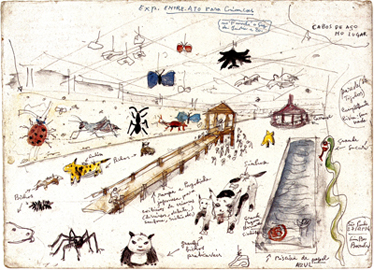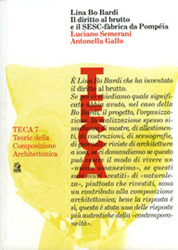You are in: Home page > Magazine Archive > Ugliness: Between Desire and Necessity.

Giuseppina Scavuzzo
Ugliness: Between Desire and Necessity.
Lina Bo Bardi. Il diritto al brutto e il SESC-fàbrica da Pompéia (1) (Lina Bo Bardi: the right to ugliness and the SESC Pompéia factory) is the title of Luciano Semerani and Antonella Gallo's new book about the Italian architect who worked in Brazil as a planner and professor of Architectural Theory, as well as being a cultural promoter. The provocative "right to ugliness" title of Semerani's essay comes from an expression used by Bardi. Its aim is to transmit turmoil, and it works. Reading the two authors' essays, we discover that this turmoil goes in a different direction to the disturbing coined by Freud and subsequently applied to architecture by Antony Vidler to describe the feeling of uninhabitability, of feeling uprooted, in the contemporary condition. By isolating this quote, the "ugliness" with which Semerani has emblematically summarised Lina Bo Bardi's discourse goes in the completely opposite direction: paradoxically, that "ugliness" becomes a hymn to the possibilities of architecture becoming fertile. It is a fertility that depends on being rooted in the most original, ancestral and visceral form that connects man to his birth on earth.
The “right to ugliness” was an expression Bardi initially used to refer to another of her interests: northeast Brazilian folk art. Later her reflection on the civic responsibility to produce objects was transferred to architecture, bringing with it the iconic and figurative power that animates her architecture. Northeast Brazilian production is pre-artisanal (artisanal knowledge had yet to be born when the Europeans first arrived in Brazil) and takes elements from prehistory and from Africa. It is practically post-industrial, reusing discarded parts from industrial products: tin, bins, light bulbs and so on. It is a condition that subverts the linearity of history and which, for Bardi, lays bare the aberrations of western modernisation and the failure of the regenerative utopia from which industrial design developed, resulting in fetishism and in the "consolation of gadgets”.
It is this popular culture that Bardi prefers to proudly ascribe to the category of ugly, rather than accepting labels such as folklore, a regressive inheritance of a craftsmanship that no longer exists in society but which survives for tourist consumption and use, or kitsch, an equally deadly acquiescence to the junk aesthetic of mass culture. On the contrary, Brazilian folk art destroys products of mass culture, chews them up and digests them thanks to an extraordinary enzyme, which is the inclination to be connected to everyday real necessities. Those objects, including ex-votos, thus contain an urgent and positive plea for life.
At least two kinds of questions regarding the language of architecture, composition, and the relationship between architecture and technique, come to architecture from these reflections on folk art and are dealt with in the two essays that make up the book. Semerani holds that the “right to ugliness” is the right to try out a different language to the dominant one, a language that subverts the rules and techniques of architectural composition, reclaiming its dignity beyond any preclusion of aesthetic order. This does not mean that the “right to ugliness” is the negation of the essential aesthetic of architecture. On the contrary, it forces a comparison with the aesthetic, leading it back to the crucial role it needs to have in architectural composition, freeing it from self-referentiality and formalism.
Bardi’s is not a personal formal world which strives for originality or draws on a culture or an idea of the world with a corresponding aesthetic that is not the codified one from western culture. It has tools and rules. These are not harmonious canons referring to principles of superior validity, but rules that find superior validity by clinging to the cyclicity of nature, in which everything is a passage from one thing to another, including metamorphosis and reuse. Animals dig lairs or live in those of other animals, transforming them; plants adapt and can grow anywhere; everything is devoured and digested and becomes fertile soil for other forms of life. Bardi believed that western culture should also be devoured and digested to become something else, something fertile to nourish new life: a literal concept of crossbreeding that does not reinterpret or translate, but is fecund and regenerates.
A language that follows these rules cannot be abstract: like the myth and magic it refers to, the sign, or figuration, dominates. Taken from folk imagery, from the Brazilian bestiary that Semerani defines “Heaven on earth without archangels”, Bardi wants to restore to us the original condition of the inhabitants of a universe uncorrupted by market needs or theology, an exuberant paradise of animal and vegetable life whose techniques of grafting, camouflage and assembly are passed on to architecture. With a compelling demonstration, Semerani describes composition reaching an ahistorical level. Bardi’s considerations on the concept of time – the linear and progressive one invented by the theological and mercantile West, and the mythical, magical one consisting of a maze of lines in which one proceeds in a circular or jumpy fashion – are thus transposed from the ideological level to the diachronicity of architectural composition.
Bardi, quoting Brecht, said that the “right to ugliness” is also an affirmation of freedom, of the “capacity to say no” to the impositions of technique and market, because “the freedom of the artist is individual but true freedom can only be collective… a freedom connected to the limitations of science, and not to the technology that has become technocracy”(2). Bardi believed that modern culture could be created in popular culture with the propulsive power of a new humanism that reverts to using technique not as an aim but as a tool of necessity. Antonella Gallo takes as a paradigm of this research the SESC Pompeia, the history of the work, the constructive practice, the life housed within a kind of architecture in which, she explains, we find the very model of the growth of the metropolis that is devoured and digested until the meaning is subverted.
Emblematic of the relationship with technique is the exposed error that Gallo describes. In various architectural traditions, such as the Jewish one, the error is sought and offered as a sacrifice of pride, a reminder of the imperfection of man and his works. In this case it is not an exercise in humility but authenticity: the effort put into the work confirms this. It is not sought in order to be humbled but to be accepted, it does not invalidate the work but is part of it like the scars on a body that has lived and struggled. The exaltation of technique and market contain an idea of beauty linked to everything that proclaims it is new, lucid, perfect, to the extent that some contemporary architecture seems to tell us, from an alien world of technological perfection, that we are too human, with our imperfect bodies that are prone to ageing. The SESC, as described by Antonella Gallo, knows how to “dispense the pleasure of the body and the psyche’s freedom” through its openings, its primitiveness and its poverty. Composition and civic responsibility are inseparable: the composition’s poetic, timeless language is regenerated by its roots and its signs; its figures become seeds, promising a potential continuation of life.
We see this awareness re-emerge even in countries in which the destruction of every root has been systematically planned and executed, in which technique, market and a misunderstood sense of modernity are allied to construct macro works that are the negation of any humanism. In China, Wang Shu builds multi-material walls in which materials from demolitions carried out in the name of growth – roof tiles, bricks, pieces of glazed tiles – are assembled according to traditional techniques, taking as a model the manual production of everyday objects. Thus, like a large metonymic figure, his Ceramic House of walls covered in pieces of glazed tiles assumes the form and principle of functionality of the ink stones used in the art of calligraphy that the architect practises on a daily basis.
Semerani and Gallo’s book, which does not follow linear time but an intertwining of timelines, returns to the present in search of more or less positive downsizing, the “wry and questioning smile of a beautiful and intelligent woman”, to quote Semerani. This stops us from being too certain that technical progress can give us what we need, which responds to our needs and fills us with desire. Gallo mentions another even more scandalously provocative feeling: pity, intended as the capacity to recognise and confer dignity to limited means, for architecture the capacity to be offered.
The Brazilian people’s ability to celebrate life is never separated from this reading of Bardi’s work. In her architecture, through those irregular holes, we glimpse the toothless smile of a baby. Perhaps out of spite we could say it is ugly in its disharmony, but it is as beautiful as a promise of happiness.
1. Semerani L., Gallo A. (2012) Lina Bo Bardi. Il diritto al brutto e iI SESC-fàbrica da Pompéia. Napoli: CLEAN
2. Bo Bardi L. (1994). Tempos de grossura: o design no impasse. San Paolo: Instituto Lina Bo e P. M. Bardi.
Giuseppina Scavuzzo (1971), researcher in Architecture and Urban Design at the University of Trieste, PhD in Architectural Composition at the University IUAV of Venice, was a reasearch fellow of the Fondation Le Corbusier in Paris.
















